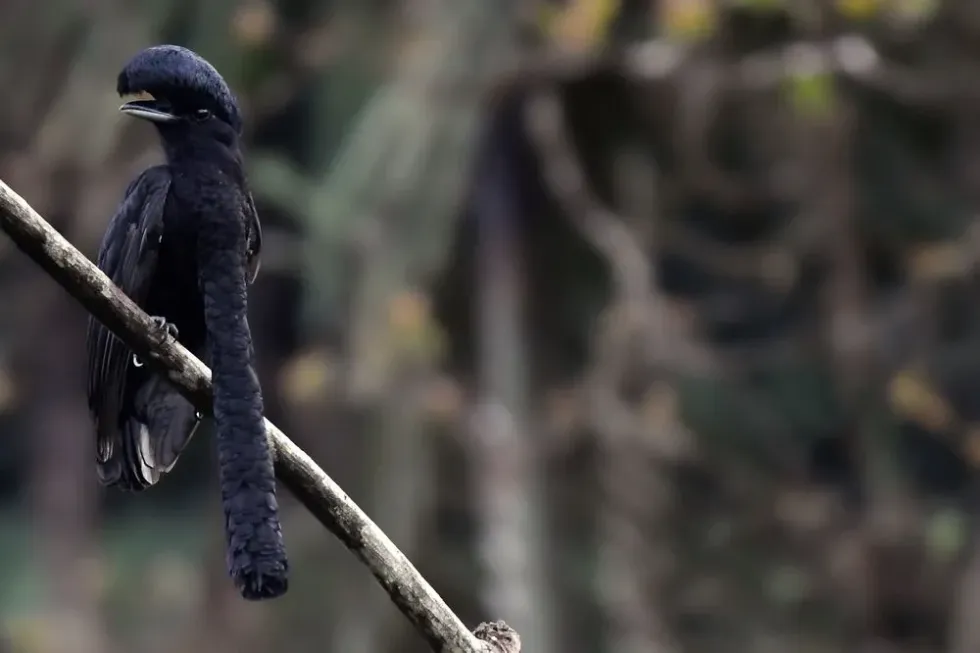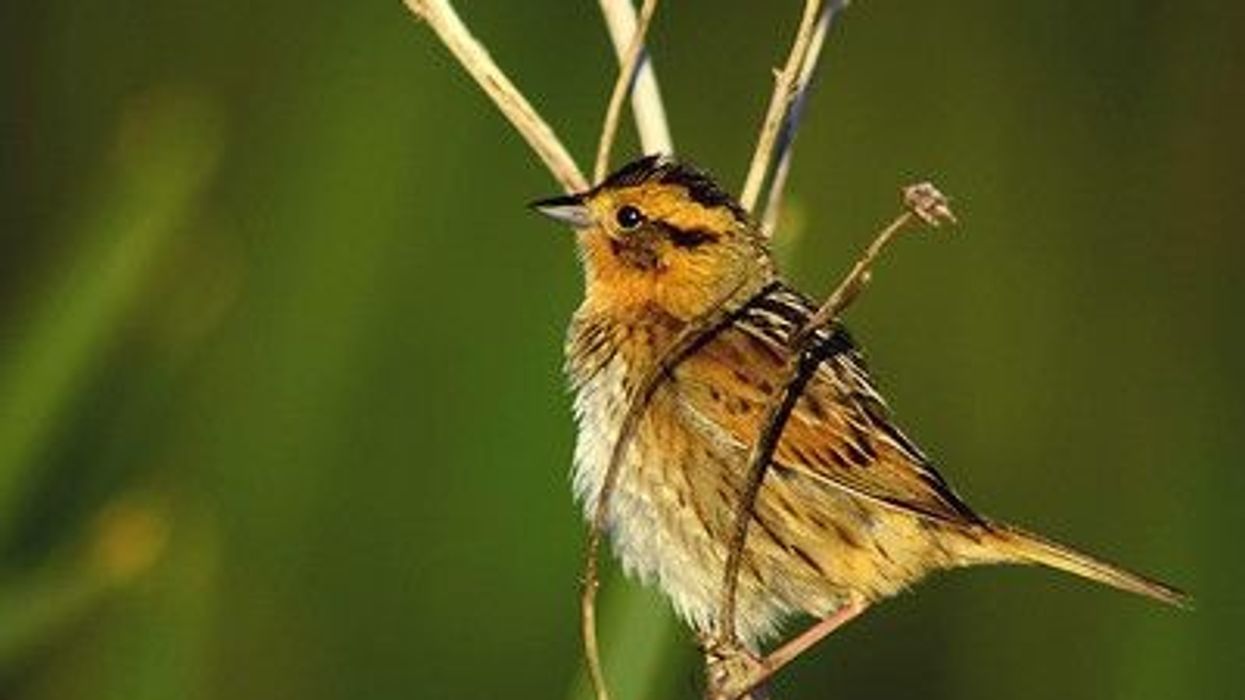The Umbrellabird, scientifically called Cephalopterus, is a large tropical bird found in Central and South America's rainforests. The Long-Wattled Umbrellabird, Amazonian Umbrellabird, and Bare-Necked Umbrellabird are three distinct Umbrellabird species that live in various parts of the rainforests.
The Amazonian male Umbrellabird is the largest member of the Cotinga family. All three species have a pendant-shaped inflatable pouch on their throats and an umbrella-like crest on top of their heads.
They are named Umbrellabirds, considering the umbrella-like crest on their heads.
The Bare-Necked Umbrellabird and Long-Wattled Umbrellabirds are threatened with extinction due to habitat loss with continued forest loss, degradation, and to a lesser extent by hunting. It lives in the tall, lush, and undisturbed rainforest in western Ecuador and western Colombia.
They are quite rare and most often seen near fruiting trees or known display sites, where several males may congregate, stretching their wattles and emitting low-pitched, airy hoots. Have you ever been fortunate enough to see this magnificent crow-like Umbrellabird with a bushy crest?
Check out below for more exciting and fun facts about this rare Umbrellabird. Don't miss reading our other similar articles on birds like birds of paradise and pileated woodpecker facts.
Umbrellabird Interesting Facts
What type of animal is a Umbrellabird?
A Umbrellabird is a tropical bird with black feathers coving the body and an umbrella-like crest on the head and a member of the Umbrellabird species. They are scientifically called Cephalopterus penduliger. Since it migrates up and down mountains rather than across land, the Umbrellabird is known as an altitudinal migrant.
What class of animal does a Umbrellabird belong to?
The Umbrellabird belongs to the family Cotingidae, class Aves, order Passeriformes.
How many Umbrellabirds are there in the world?
Although these birds' specific population at present is unknown, based on available records, descriptions of abundance, and range size, the population is estimated to number 6,000-15,000 birds.
Where does a Umbrellabird live?
The Umbrellabirds tend to live in the mid-to upper-story of tall trees of Central and South America tropical forests. These birds spend most of their time jumping high from branch to branch in the canopy.
What is a Umbrellabird's habitat?
The Umbrellabird can be found in Central and South America's subtropical belts. The Long-Wattled Umbrellabird Cephalopterus penduliger species has a high level of biodiversity and can be found in the bioregion Tumbes-Chocó-Magdalena, the southwestern part of Colombia to El Oro's province in Ecuador.
The Umbrellabird spends most of the year in lowlands and mountain foothills, usually at elevations of less than 500 m in the humid and moist forest. They do, however, migrate higher into the mountains during the breeding season.
Who do Umbrellabirds live with?
The Umbrellabird is a solitary bird observed coexisting among their three Umbrellabird species or with birds like the woodpecker.
How long does a Umbrellabird live?
The Long-Wattled Umbrellabird Cephalopterus penduliger has an average lifespan of 12-20 years lifespan.
How do they reproduce?
Males of Umbrellabirds congregate in small groups to select a mate. Females in these areas observe the loudly-calling males and select their mate.
A lek is the name for this courtship grouping. After mating, the females build a large nest out of twigs, moss, and leaves inside a tree branch at heights that is often high above the ground. After that, the female lays a single egg incubated for one month.
What is their conservation status?
Out of the three species, IUCN has listed the Long-Wattled Umbrellabird and Bare-Necked Umbrellabird as Vulnerable. As infrastructure develops and colonization frontiers advance, hunting pressure is rapidly increasing. It's simple to find traditional lek sites and approach showing males, making it a convenient bag for hunters.
The Long-Wattled Umbrellabird Cephalopterus penduliger can be found in some protected areas. It has been proposed that the species would benefit significantly from the consolidation of existing scattered reserves and the designation of several existing protected areas as biosphere reserves. Forest composition management and reforestation have been mentioned as essential approaches.
Umbrellabird Fun Facts
What do Umbrellabirds look like?
Umbrellabirds are primarily black with an inflatable pendant-shaped pouch on their throat and a distinctive umbrella-like crest on the head. Umbrellabirds come in three species, all of which have thick black scaly feathers covering their bodies; each subspecies has its imprint. The sharp, powerful claws help them maintain a firm grip on branches when calling.
The Long-Wattled Umbrellabird's male species is identified by its wattle covered with scaly feathers hanging from its chest and is almost 14 in (35 cm) long. Females look the same as males, but with a smaller crest and wattle smaller in size. The male bird species activates the wattles and crests as ornaments and attracts the female.
How cute are they?
Umbrellabirds are cute, with their black feathers and an umbrella-like crest on their head makes them even more beautiful.
How do they communicate?
No precise information is available on this species' way of communication. However, like any other bird, the Cephalopterus penduliger of order Passeriformes communicates through their behavior and sounds. During the breeding season, the male Long-Wattled Umbrellabird makes loud grunting and low sound booming calls and raises their crests to attract their mates.
How big is a umbrellabird?
The umbrellabird measures 14-20 in (35-50 cm) long and 15-20 in (38- 50 cm) tall and is the largest in their Cotinga family. The Amazonian umbrellabird is of the largest size among all the subspecies.
How fast can a umbrellabird fly?
Umbrellabird is not a good flying bird. They can and do fly, but very slowly and they are clunky in the air.
These birds have a distinctive slow flapping with the crest lying flat during the flight. They'll jump clumsily from branch to branch until they've found a perch. However, during mating season, they fly up and down the mountains in their habitat.
How much does a umbrellabird weigh?
The umbrellabird weighs between 11-20 oz (320-570 g) and the females are a little smaller in size.
What are their male and female names of the species?
Both male and female birds are called umbrellabirds. The female birds have a smaller wattle and umbrella-like crest and are smaller in size than males.
What would you call a baby umbrellabird?
Chick is the name by which we call a 'baby umbrellabird'.
What do they eat?
The umbrellabird being an omnivore eats fruits and vegetables and a variety of invertebrates. Large insects, larvae, spiders, berries, palm fruits, nuts, and others make up their diet. The umbrellabird is an integral part of their ecosystem since it disperses seeds from the fruit it eats in the forests.
Are they dangerous?
There is no clear evidence proving umbrellabirds to be dangerous; however, its decreasing population puts it in danger of extinction today.
Would they make a good pet?
Petting a umbrellabird is not a good idea. These birds are noted for adapting well to their natural environment only.
Did you know...
Did you know that the umbrella-like crest on the bird's head is the reason for its name of umbrellabird? The long-wattled umbrellabird got its common name from the long wattle that the male bird carries, and its scientific name 'penduliger' comes from the Latin word 'pendulus,' which means 'hanging', referring to the wattle.
Monkeys, snakes, and massive birds of prey such as hawks and eagles are the umbrellabird's primary predators.
Is the umbrellabird endangered?
The long-wattled umbrellabird and the bare-necked umbrellabird are threatened by habitat loss caused by development, logging, road construction, and gold mining. Intensive agricultural production is a significant contributor to deforestation. The current long-wattled umbrellabird count is estimated to be between 6,000-15,000 birds.
Different types of umbrellabird
The three different umbrellabird types are the long-wattled umbrellabird, bare-necked umbrellabird, and Amazonian umbrellabird. All three subspecies almost look the same.
The long-wattled umbrella is distinguished by its wattle coated in scaly feathers and hangs from its chest. The bare-necked umbrellabird is distinguished from the others by a reddish, featherless patch of skin on its throat. The Amazonian umbrellabird is entirely black and the largest of all the species.
Here at Kidadl, we have carefully created lots of interesting family-friendly animal facts for everyone to discover! Learn more about some other birds including secretary bird, or great green macaw.
You can even occupy yourself at home by drawing one on our Umbrellabird coloring pages.









